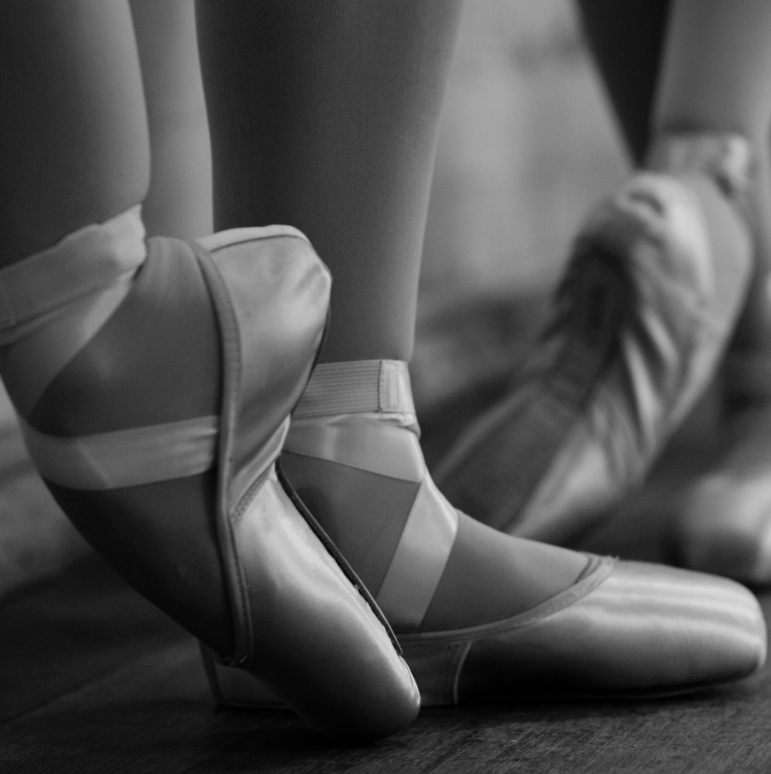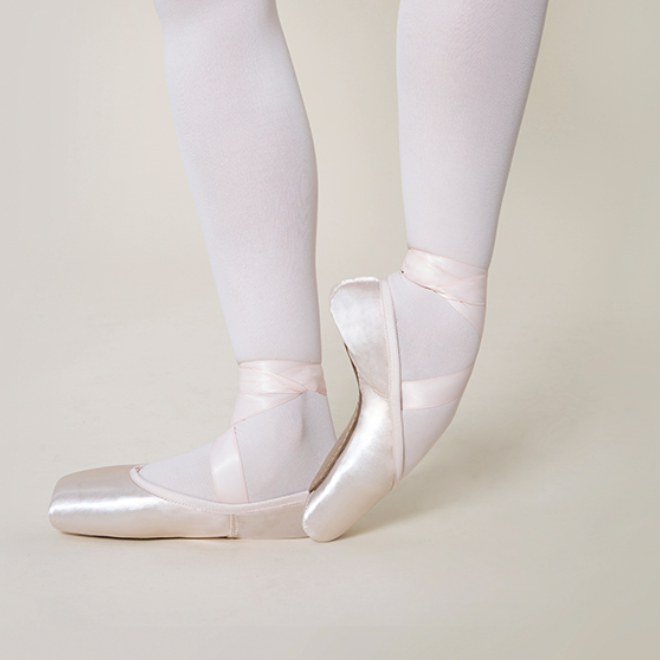Pointe Shoes: The Perfect Fit
Not many shoes have the power to completely transform their wearer the way a pair of pointe shoes can. Stepping 'en pointe' is an exhilarating moment for a dancer, one that - quite literally - allows them to reach new heights, and perform feats that far surpass what was once thought possible. Today's pointe shoe is the sleeker, smarter and more durable reincarnation of the first pointe shoe that was worn by Marie Taglioni back in the 1830's. With every evolution since, pointe shoes have become more refined, more specialised and more capable of meeting the dancer's every need, whether that be balance, support, endurance or comfort. Yet often the considerations and design that goes into the creation of the modern pointe shoe can go unnoticed, leaving the exact art of finding 'the perfect pointe shoe' somewhat of a mystery.
If you've ever wondered about the anatomy of a pointe shoe's design, or what a pointe shoe fitter looks for to find that perfect pair, here is our ultimate guide to all things pointe-related.
A dancer's guide to pointe shoes and finding the perfect fit.
Click here for a printable PDF version
Anatomy of a Pointe Shoe:
The pointe shoe box is the front-most part of the pointe shoe, and encases and supports the dancer’s toes. The box is generally made of compressed layers of fabric and paper, hardened with glue to make a solid platform for the dancer to balance on. Boxes can come in varying shapes to suit the feet of the dancer:
Tapered Box – This style narrows in width towards the tip of the toes, to allow for dancers with narrow feet, ‘tapered’ or ‘Egyptian’ toes (pictured).
Medium/Slightly Tapered Box – often suitable for more average-width feet, or feet with some toes equal to or longer than the big toe, ie. ‘Peasant’ or ‘Greek’ tapered toes.
Square Box – this box shape has only very slight tapering, making it almost as wide at the platform (the area of the shoe you rise onto) as it is at the other end of the box. This style is ideal for wider feet with ‘square toes’, ie. Toes that are almost equal in length, or 'greek toes' that are less tapered.
The vamp refers to the upper part of the pointe shoe, beginning at the drawstring (for shoes that have one), and covering the top of the toes. The length of the vamp is determined by toe length, foot width as well as arch and ankle flexibility, and can be short, medium or long. This, combined with the style and size of the box, and the strength of the shank are the three most crucial elements in getting a perfect fit for your foot.
The platform is the hard, flat surface at the tip of the pointe shoe which provides a smooth, oval-shaped base for the dancer to balance on when en pointe.
The wings are the two lateral panels on the sides of the box, that provide support to the outer toes as well as up the sides of the feet whilst the dancer is en pointe.
The shank is a hard material (often leather, carboard and/or burlap) that stretches the length of the shoe, and reinforces the sole to support the dancer’s arch whilst en pointe. Shanks come in varying strengths to suit the strength and flexibility of the dancer’s feet and arches - I.e. high arches will likely suit a stronger shank than flatter arches.
The insole is the inner bottom surface of the pointe shoe that sits directly beneath the dancer's foot and is normally made of suede or cotton to absorb moisture and provide a more comfortable surface for the foot to rest against. The insole also covers the shank and is usually adhered with nails or glue.
The outer sole is the section of shoe that is in direct contact with the floor when a dancer is standing on flat. Outer soles are generally made of a synthetic or leathery material and scored or ridged to provide traction, and is attached to the bottom of the pointe shoe through stitching around the edges.
The overall shape of the shoe is determined by the width of the foot across the metatarsals and the width of the heel (back portion of the shoe). A foot that tapes towards the heel will fit a 'Diamond shape' shoe with a narrower heel, and a foot that is a consistent width from toe to heel will suit a 'rectangular shape'.
The shoe profile (or crown) refers to the height of the shoe from the side, and is determined based on the profile height of the dancer’s foot. Someone with a foot that has quite a high profile (meaning the distance from the top of the foot to the sole is quite large and the foot extends ‘high’ off the ground) will usually have a high profile. However a shoe’s profile height can also be influenced by the compressibility of a dancers feet.
Accesories:
As well as having an incredible range of options available in the pointe shoe itself, dancers today also have a wide variety of tools available to help them customise the shoe to their exact foot shape and to minimise discomfort. Dancers can pad their shoes with Pointe Pouches, which cushion the ball of the foot, tips and top of the toes with protective gel, Pro Pointe Pouches which only cushions the tip of the toes and tops of the feet, Toe Spacers, which can be either 'Spreaders' or 'Separators' that help space the toes evenly inside the shoe and fill in any gaps that might cause sinking or pain. Then there's Toe Tubes - hollow elastic tubing that prevents rubbing and blisters by protecting the toes with a gel lining and comes as 1/2 Gel, Full Gel, or 'Tippy Toes' (tubing that also covers the ends of the toes to provide extra cushioning on pointe). There's Lambswool, for more specific contour and padding, allowing you to choose the exact amount and shape you need for each foot, and lastly Suede Toe Caps (which cover the outer platform of the shoe) and Rosin (which is crushed and stepped in to cover the soles and platforms of the shoe) which both give the shoes more grip on slippery surfaces.
The Dancers Foot:
Dancers’ feet can be as varying and diverse as the dancers themselves, and each variation in width, flexibility, toe length, strength, and every other characteristic will determine exactly which style of pointe shoe will most help to enhance and support the individual dancer.
Below is a summary of each of the characteristics that your pointe shoe fitter will examine to find your exact foot type.
Click here for a printable PDF version
The instep is the topmost surface of the foot between the toes and the base of the ankle. The level of ‘curve’ or flexibility you have here combined with the flexibility of your arches and ankles determines how ‘bendy’ your feet are, and what type of shank will suit you best.
The arch is the curved area underneath the foot (mirroring the instep) which is used to assess the foot type according to ‘flatness’. Someone with a high arch will have a large gap between the middle of their arch and the floor, whereas someone with no arch will have no gap at all (this is called ‘flat feet’), which can make pointe work – and rising en pointe in particular - challenging if not properly fitted.
Similar to the pointe shoe profile (or crown), the foot profile refers to the amount of distance between the top and bottom of the foot at it’s mid-section. This measurement is important for selecting the box shape and profile height of the pointe shoe, as too low of a shoe profile will result in the foot ‘spilling over’ on pointe, and too high of a profile will make the toes sink down painfully into the box.
Foot compressibility isn't a part of the foot, but a rather a measurement of the amount of lateral ‘compression’ that occurs over the metatarsals, which will in turn impact which box width is most suitable for the foot. For example, a wide foot may initially appear to suit a wide, square box, but if the foot has great compressibility (narrows significantly when squeezed lightly by the fitter) it would be far more suited to a narrower, slightly tapered box, as a wide box would result in the dancer sinking down into the shoe when en pointe.
The length of toes, and length of each toe in relation to the others also greatly affects the box type that will be most suitable for the dancer: someone with a second toe that is much longer than the other toes (including the big toe) will usually best suit a tapered box (one that narrows toward the toes) to minimise the empty space inside the end of the shoe, fully support the foot and reduce the amount of sinking. Egyptian, Peasant, Square and Greek are the most common variations amongst foot types due to toe length (see examples of toe shape in the illustration above).
Jessi Seymour wears Energetiks Thea Pointe Shoe
With so many important things to consider when looking at pointe shoes, it's little wonder why being fitted by a professional, trained pointe shoe fitter is so beneficial for dancers. A good pair of pointe shoes can transform your dancing by enhancing the feet and the line of the legs, and making the experience of dancing en pointe feel natural, comfortable and secure.
Makensie Henson wears Energetiks Stella Pointe Shoes
One of our team of Pointe Shoe Fitters, Amy Ford describes what being an experienced Energetiks fitter entails for each trained and qualified team member:
"As pointe shoe fitters we understand how crucial a correctly fitted pointe shoe is to a dancer and we make it our mission to fit each dancer in a shoe that perfectly complements the very specific technical needs, ability and requirements of your feet, as well as your personal preferences. Every pair of feet are different as is every dancer and so every pointe shoe fitting is a unique process we tailor to meet your needs and ensure you walk away happy and confident that you have the perfect shoes."
For our full range of pointe shoes and pointe shoe accessories, or to book a pointe shoe fitting, see here:
www.energetiks.com.au
Ph: 1300 287 297
Article by Elly Ford




















